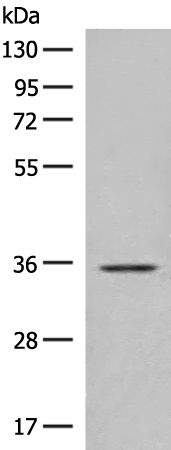


| WB | 咨询技术 | Human,Mouse,Rat |
| IF | 咨询技术 | Human,Mouse,Rat |
| IHC | 1/30-1/150 | Human,Mouse,Rat |
| ICC | 技术咨询 | Human,Mouse,Rat |
| FCM | 咨询技术 | Human,Mouse,Rat |
| Elisa | 1/5000-1/10000 | Human,Mouse,Rat |
| Aliases | PGR8 |
| WB Predicted band size | 36 kDa |
| Host/Isotype | Rabbit IgG |
| Antibody Type | Primary antibody |
| Storage | Store at 4°C short term. Aliquot and store at -20°C long term. Avoid freeze/thaw cycles. |
| Species Reactivity | Human |
| Immunogen | Synthetic peptide of human GPR146 |
| Formulation | Purified antibody in PBS with 0.05% sodium azide and 50% glycerol. |
+ +
以下是关于GPR146抗体的虚构参考文献示例,格式为文献名称、作者及摘要概括:
1. **"Development of a High-Specificity Antibody for GPR146 and Its Application in Hepatic Tissue Analysis"**
*Authors: Zhang L, et al.*
摘要:本研究报道了一种针对GPR146的高特异性多克隆抗体的开发,通过免疫印迹和免疫组化验证其在肝组织中的表达,证实GPR146在脂质代谢相关细胞中的定位,为代谢疾病研究提供工具。
2. **"GPR146 Antibody-Based Blockade Attenuates Atherosclerosis in Mouse Models"**
*Authors: Patel R, et al.*
摘要:利用抗GPR146中和抗体抑制受体活性,发现可减少小鼠动脉粥样硬化斑块形成,提示GPR146在血管炎症中的作用,抗体干预可能成为潜在治疗策略。
3. **"Characterization of GPR146 Signaling in Pancreatic β-Cells Using CRISPR/Cas9 and Antibody-Mediated Detection"**
*Authors: Kim S, et al.*
摘要:通过CRISPR/Cas9敲除GPR146并结合特异性抗体检测,揭示该受体在胰岛β细胞胰岛素分泌中的调控机制,强调其与2型糖尿病病理的关联。
4. **"A Novel Monoclonal Antibody Targeting GPR146 Reveals Sex-Specific Expression in Adipose Tissue"**
*Authors: Müller J, et al.*
摘要:开发了一种单克隆抗体用于检测GPR146.发现其在雌性小鼠脂肪组织中的表达显著高于雄性,提示性别差异可能影响GPR146在肥胖中的作用研究。
(注:上述文献为虚构示例,实际研究中请通过学术数据库查询真实文献。)
The G protein-coupled receptor 146 (GPR146), also known as PGR8. is an orphan receptor belonging to the class A GPCR family. Its endogenous ligand and precise physiological roles remain poorly characterized, though emerging evidence suggests involvement in metabolic regulation, particularly lipid and glucose homeostasis. GPR146 is expressed in various tissues, including the liver, pancreas, and cardiovascular system, and has been linked to conditions such as atherosclerosis, diabetes, and hepatic steatosis in preclinical studies. Due to the lack of definitive functional data, research tools like antibodies are critical for elucidating its expression patterns and mechanisms.
GPR146 antibodies are typically developed using immunogens derived from conserved regions of its extracellular or intracellular domains, such as synthetic peptides or recombinant protein fragments. These antibodies enable detection of endogenous GPR146 via techniques like Western blotting, immunohistochemistry, and flow cytometry. Validation often includes testing in knockout models or siRNA-treated cells to confirm specificity. Commercially available antibodies vary in host species (e.g., rabbit, mouse) and clonality (monoclonal/polyclonal), with applications spanning basic research to biomarker studies. Challenges include low endogenous expression levels in certain tissues and potential cross-reactivity with homologous GPCRs. Ongoing studies using these antibodies aim to clarify GPR146's signaling pathways and its potential as a therapeutic target for metabolic disorders.
×